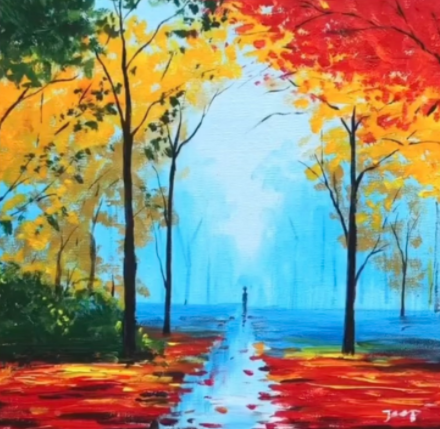The Leaves are Changing… and not in a Good Way

Art by Camille Xu
January 4, 2022
Every Autumn, a symphony of reds, oranges, and yellows have distinctly marked the hills, mountains, and valleys. With many people following the fall foliage from Canada to New England to the Appalachia and northern Midwest, this practice is called leaf peeping. These locations also depend on the changing leaves for tourism revenue with areas like New England gaining $8 billion in revenue each year from the fall tourism [4]. However, this past foliage was distinctively delayed and contained more muted colors than previous years. Scientists have attributed climate change, invasive species, and a shifting forest landscape to the reason behind this change.
During the spring and summer months, deciduous trees are green from the chlorophyll in their leaves. When the growing season ends, senescence occurs, which is the process of leaves changing colors and falling off. With the coming of Autumn, the difference in temperature, precipitation, and light slows down the process of photosynthesis. Chlorophyll breaks down allowing carotenoids,
xanthophyll, and anthocyanins to appear.
These pigments are responsible for the orange, yellow, and red colors respectively. Allison Gill and a group of researchers conducted a study on leaves changing colors in the northern hemisphere [3]. They took data from 1993 – 2010 from the northeast, Europe, and Japan. Their results showed that October temperatures were the greatest drive to leaf fall and day length, latitude, and precipitation are also factors. At low-latitude locations, temperature was a stronger factor compared to higher latitude places, which suggested that site-specific factors drove leaf senescence. The researchers predict that areas in the north experience the impacts of climate change more severely. However, more research is needed to fully understand how climate change is impacting senescence.
Without a doubt, climate change has impacted leaf coloration and falling off. The rising heat has extended the growing season, which in turn delays the time leaves change color. Marc Abrams, a professor of forest ecology and physiology at Penn State, has found that the growing season has grown by roughly ten to fourteen days by looking at the growth of tree rings [5]. Additionally, more frequent extreme weather causes leaves to fall before the leaves are able to change colors. With hurricanes becoming more severe, they can destroy trees and their leaves. For example, in 2011, Hurricane Irene carried salt inland, damaging the cells and tissues in a tree [4]. On the other hand, extreme droughts can accelerate the changing of colors. Trees aren’t able to adapt to these changes fast enough as Tanisha M. Williams, the Burpee postdoctoral fellow in botany at Bucknell University, puts it: “These species have been adapting for millions of years, and we’re putting them through a stress test in a very short period of time. It’s shocking their system” [1]. Trees are being put through so many environmental changes, they aren’t able to keep up and it’s visibly seen in their changing leaves.
The warming temperatures also help invasive species thrive as they are more accustomed to warmer temperatures from their native home. Coming from imported lumber or packing material, insects like the Hemlock Woolly Adelgid or Emerald Ash Borer have been destroying Eastern Hemlocks and Ash Trees respectively [1]. Additionally, the greater precipitation has increased the growth of leaf spotting fungi which can harm trees like the sugar maples, a tree that is greatly known for its bright colors. Since these invasive species only target certain trees, they can drastically change the landscape.
A shifting forest landscape is also contributing to the different leaf viewing experience. The types of species have greatly changed since the 1930s. With a decline in oak, pine, hickory species, it has allowed red maple, black birch, tulip poplar, blackgum to grow. This has the ability to drastically change the composition of colors that make up a forest.
Ultimately, many factors are contributing to the everchanging fall foliage. The once bright spectacle is described by Howard Neufeld, a plant ecophysiologist at Appalachian State University, as “some trees will continue to turn color early; others will delay and turn color later. So instead of having this explosion of color in a short period of time, you get different groups of trees turning color over an extended time” [1]. Leaf peepers will have to change their perception on viewing the autumn leaves. In the meantime, scientists will continue conducting research and trying to understand the explanation for the changing fall foliage and how climate change impacts it.
Sources:
[2]https://www.popsci.com/story/environment/climate-change-fall-leaves-earlier/?amp
[3]https://daily.jstor.org/will-we-lose-fall-foliage-to-climate-change/
[4]https://www.neefusa.org/nature/land/leaves-they-are-changing

Shree Manivel • Jan 11, 2022 at 3:42 pm
Awesome article – very informative and well-written!
Yuying Wang '23 • Jan 10, 2022 at 8:27 am
What a beautifully written article, Angie!